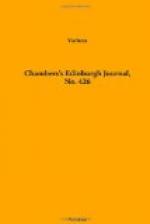Talking of travel: the Legislative Council at Sydney have granted L.2000, to fit out an expedition to search for Leichardt; Captain Beatson, with his steamer, is about to start for Behring’s Strait to look for Franklin; Lieutenant Pim has returned from St Petersburg—the emperor would not permit him to go to Siberia; and last, supplies of money and goods have been sent out to Drs Barth and Overweg, in Central Africa, to enable them to pursue their discoveries; and the British resident at Zanzibar has been instructed to assist them. We may thus hope, before long, to add to our knowledge both of the torrid and frigid zones.
To touch upon a home topic: we are told that government are rather afraid of their own bill for intermural interments passed last session, which may account for none of its provisions having yet been carried out. The project now is to supersede that bill by another, which is to extend the practice of cemetery interment. This looks like a want of faith in sanitary principles. On the other hand, the sale of the lazaretto at Marseilles, with a view to construct docks on its site, is a proof that the French government can do something in the way of sanitary reform. It is, in fact, quite time that the superstitious notions about infection, and the vexations of quarantine, should give place to sounder views and more rational methods. Meantime, as meteorologists say, we are coming to the cycle of hot summers, it behoves us more than ever to bury the dead far from towns. The Registrar-General tells us that, on the whole, we are improving, and it is not less an individual than a national duty to forward the improvement. According to the return just published for the quarter ending December last, the births in 1851 amounted to 616,251, the largest number ever registered, being an excess of 5 per cent. over former returns. The deaths were 385,933, leaving a surplus which increases the population of England and Wales to more than 18,000,000. In the same quarter, 59,200 emigrants, chiefly Irish, left the kingdom. With respect to marriages,




